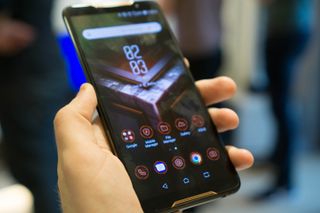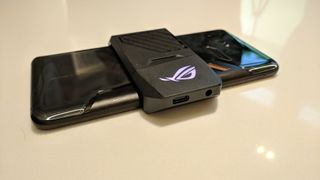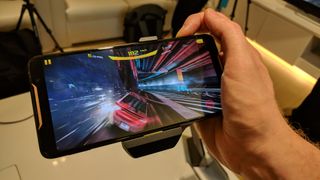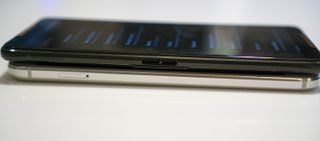Asus takes aim at mobile gamers (and Razer) with a feature-packed gaming smartphone
The ROG phone is packed with gaming gimmicks, including "air triggers" and specially picked 2.96 GHz CPUs.

There's always money in the banana stand, and there's always money in mobile gaming. Asus, best known for its motherboards and laptops and monitors, wants in on that action, so it's using the ROG brand to make a smartphone for gamers. Given the complete failure of older gaming phones, I wasn't optimistic. Millions of teens already play Fortnite and PUBG and tons of other games on their phones. What would a gaming phone really offer them?
After getting my hands on the phone, though, I have to hand it to Asus: the ROG smartphone says it's all about gaming, and it goes for it. Let's compare this new phone with the Razer phone, released in late 2017. Razer's only real gaming-focused features with the phone were its 120Hz, 2560x1440 IGZO display and dual speakers. And it had overall strong specs. Otherwise, it was a pretty straightforward, cleanly designed phone that fit with Razer's aesthetics.
Next to the Razer phone, the ROG phone is more like The Homer. It also has a really impressive display. While it's lower resolution at 1080, and slightly lower refresh at 90 Hz, it's an HDR AMOLED display with a 1ms response time. It's vibrant and gorgeous. Then the gaming-focused features start to stack up. Dual front-facing speakers. A vapor chamber design for better heat dissipation. A second charging port on the side, optimized for playing games in landscape and being able to charge with a comfortable grip.

Now here's the really crazy part: there an attachable fan, the "aero active cooler," that clips onto the back of the phone and provides even more cooling. Asus plans to ship these with every phone. It clips into that side charging port and offers a couple passthroughs: USB-C and 3.5mm audio. There's a headphone jack on the bottom of the phone, too. The dream still lives.
And somehow there are still more gaming features. The corners of the phone on the right side have small "Air Triggers" which are areas you can tap, and they essentially serve as shoulder buttons, giving you some game control without having your fingers on the touchscreen. These should work with any mobile game that supports mapping to a controller. Asus talked up the power of its haptic feedback, and made a point of the phone's charger, which has its IC in the wall unit instead of the phone, to keep the phone cool while charging. It also supports Qualcomm's Quick Charge 3.0 and 4.0 standards, and it's all USB-C.

Inside there's a faster system-on-a-chip than any phone currently available: Asus is using the Snapdragon 845, and specifically selecting the highest performing CPUs that can hit 2.96 GHz. Asus showed the ROG phone beating everything else in a number of benchmarks, though as usual it's a safe bet that this fall's iPhone will retake that crown. A 4,000 mAH battery pretty much rounds things out.
This is a big phone, though after the laundry list above, it's surprisingly thin and feels good in the hand. It also has the ROG "gamer" aesthetic all over it, especially when you look at the back. This is a phone that looks like it's in a case, even when it's not in a case. The UI is similarly game-ified, though underneath the skin it's running something pretty close to stock Android 8. The aesthetic seems to fly in the face of what most smartphone makers are going for with smooth, sleek, and simple designs. Considering gamer hardware sells, though, there must be a market for this kind of look.
The biggest gaming news, reviews and hardware deals
Keep up to date with the most important stories and the best deals, as picked by the PC Gamer team.
Aside from the phone, Asus has also built a dock that you can plug HDMI and a load of USB peripherals into to essentially turn the phone into a gaming desktop. There's also going to be a bundle option that uses a wireless WiGig hub to beam the phone's display to your TV. I tried playing a game that way for a few minutes, and couldn't detect any input lag in the experience. It felt comparable to playing with a wireless controller.

I don't know if there are enough people out there who want a gaming-focused smartphone to make the ROG phone a success. But if it ends up another in the long line of failed gaming smartphones, it won't be for lack of trying. This is a serious piece of hardware. No word on price (or a final name) yet, but the phone should be out in Q3 of this year.

Wes has been covering games and hardware for more than 10 years, first at tech sites like The Wirecutter and Tested before joining the PC Gamer team in 2014. Wes plays a little bit of everything, but he'll always jump at the chance to cover emulation and Japanese games.
When he's not obsessively optimizing and re-optimizing a tangle of conveyor belts in Satisfactory (it's really becoming a problem), he's probably playing a 20-year-old Final Fantasy or some opaque ASCII roguelike. With a focus on writing and editing features, he seeks out personal stories and in-depth histories from the corners of PC gaming and its niche communities. 50% pizza by volume (deep dish, to be specific).
Most Popular






